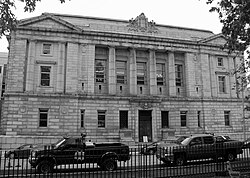2000 census
As of the 2000 census, there were 265,612 people, 107,989 households, and 67,709 families living in the county. The population density was 318 inhabitants per square mile (123/km2). There were 122,600 housing units at an average density of 147 per square mile (57/km2). The racial makeup of the county was 95.74% White, 1.06% Black or African American, 0.29% Native American, 1.40% Asian, 0.04% Pacific Islander, 0.35% from other races, and 1.13% from two or more races. 0.95% of the population were Hispanic or Latino of any race.
There were 107,989 households, out of which 30.10% had children under the age of 18 living with them, 50.10% were married couples living together, 9.50% had a female householder with no husband present, and 37.30% were non-families. 28.40% of all households were made up of individuals, and 10.20% had someone living alone who was 65 years of age or older. The average household size was 2.38 and the average family size was 2.95.
In the county, the population was spread out, with 23.30% under the age of 18, 8.40% from 18 to 24, 31.30% from 25 to 44, 23.60% from 45 to 64, and 13.30% who were 65 years of age or older. The median age was 38 years. For every 100 females, there were 93.80 males. For every 100 females age 18 and over, there were 90.20 males.
The median income for a household in the county was $44,048, and the median income for a family was $54,485. Males had a median income of $35,850 versus $27,935 for females. The per capita income for the county was $23,949. About 5.20% of families and 7.90% of the population were below the poverty line, including 9.10% of those under age 18 and 7.40% of those age 65 or over.
19.6% were of English, 15.5% Irish, 9.6% French, 7.8% United States or American, 7.7% Italian, 6.3% French Canadian and 5.9% German ancestry according to Census 2000. 94.4% spoke English and 2.1% French as their first language.
2010 census
As of the 2010 United States census, there were 281,674 people, 117,339 households, and 70,778 families living in the county. [11] The population density was 337.2 inhabitants per square mile (130.2/km2). There were 138,657 housing units at an average density of 166.0 per square mile (64.1/km2). [12] The racial makeup of the county was 92.8% white, 2.4% black or African American, 2.0% Asian, 0.3% American Indian, 0.6% from other races, and 1.8% from two or more races. Those of Hispanic or Latino origin made up 1.8% of the population. [11] In terms of ancestry, 22.7% were English, 21.1% were Irish, 9.0% were German, 8.4% were Italian, 6.0% were Scottish, 5.5% were French Canadian, and 4.4% were American. [13]
Of the 117,339 households, 28.3% had children under the age of 18 living with them, 46.8% were married couples living together, 9.7% had a female householder with no husband present, 39.7% were non-families, and 29.7% of all households were made up of individuals. The average household size was 2.32 and the average family size was 2.90. The median age was 41.0 years. [11]
The median income for a household in the county was $55,658 and the median income for a family was $71,335. Males had a median income of $48,158 versus $38,539 for females. The per capita income for the county was $31,041. About 6.9% of families and 10.5% of the population were below the poverty line, including 14.4% of those under age 18 and 7.5% of those age 65 or over. [14]




